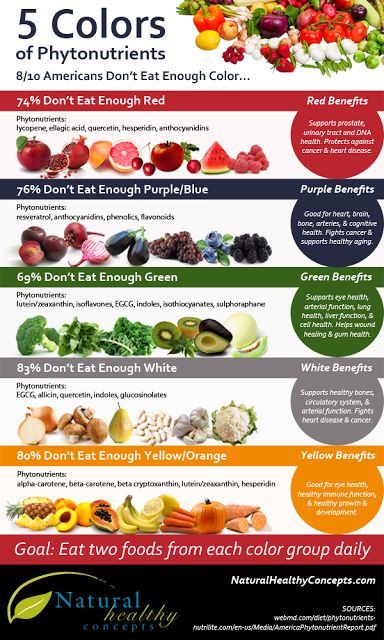Beige and black may be all the rage in many wardrobes but when it relates to a healthy diet, color is the way to go. Why? One word: phytochemicals. The more colorful your plate the more phytonutrients in your food and the more phytonutrinets on your plate the more health benefits you will be eating. I always say that the best form of health insurance is prevention. As I tell all of my patients, a beige diet may be cheap, taste good to you and fill you up, but it also may cost you more later as they tend to be high in unhealthy fats, highly processed and usually nutrient depleted foods. This puts your health at risk. So choose to eat wisely now and there is no better time then the beginning of summer with the abundance of produce and healthy fresh choices.
Phytochemicals act as antioxidants, can protect your cells from injury, aging and cancer. They can help regenerate essential nutrients and they can also help in the detoxification of certain chemicals that are in our environment and help to inhibit and deactivate cancer-causing substances. WOW! All that in a little color on your plate. And the beauty is that these potent substances occur naturally in plants and because its summer, they are everywhere! Summer time means sunshine, greenery, longer days and warmer evenings, more time to savor all the beauty of the outdoors. Plants are in abundance, beauty abounds, and nature gloriously shares all of its incredible fresh healthy bounty with us. In my healthy world, summer is all about the amazing abundance of healthy, fresh, whole foods and there’s no better time to eat well, be well and feel fabulous.
So what exactly is behind the color of your food?

Green:
The natural plant pigment chlorophyll colors green fruits and vegetables. Green foods are rich in isothiocyanates, which induce enzymes in the liver that assist the body in removing potentially carcinogenic compounds. For example, cruciferous veggies such as broccoli and cabbage contain the phytochemicals indoles and isothiocyanates, which may have anticancer properties.
Green vegetables are also an excellent sources of vitamin K, folic acid, potassium, as well as carotenoids and omega-3 fatty acids. Folic acid is needed to prevent neural tube defects during pregnancy, and vitamin K is essential in blood clot formation. Diets high in potassium are associated with lowering blood pressure, and there is an inverse relationship between cruciferous vegetables and cancer, especially colon and bladder cancers. In addition, sulforaphane, a phytochemical present in cruciferous vegetables, was found to detoxify cancer-causing chemicals before they do damage to the body.
Yellow/Green:
A variation of the green color category, these foods exhibit a richness in lutein. Lutein is particularly beneficial for eye health. There are lutein receptors in the macula of the eye, and lutein helps protect against age-related macular degeneration.
Another reason to grab some yellow/green kiwifruit at the grocery store is its high amount of vitamin C, a super powerful natural antioxidant that is essential for collagen formation in the skin and improving the immune system. Sources of these potent antioxidants include; Avocado, kiwifruit, spinach and other leafy greens, pistachios
Relish Ruby Reds:
Lycopene is the predominant pigment in reddish fruits and veggies and this carotenoid, lycopene, is a powerful antioxidant that has been associated with a reduced risk of some cancers, especially prostate cancer, and protection against heart attacks. Look for tomato-based products for the most concentrated source of this phytochemical. Tomatoes also help to support the health of prostate and breast tissue.
And although some nutrients, such as vitamin C, are diminished with the introduction of heat, the benefits of eating produce are not dependent on eating raw foods. In fact, cooking enhances the activity of some phytochemicals, especially lycopene. Cooked tomato sauces are associated with greater health benefits compared with the uncooked version because the heating process allows all carotenoids, especially the lycopene, to be more easily absorbed by the body.
In addition to vitamin C and folate, red fruits and vegetables are also sources of flavonoids, which reduce inflammation and have antioxidant properties. Cranberries, another red fruit whose color is due to anthocyanins, not lycopene, are also a good source of tannins, which prevent bacteria from attaching to cells.
Yellow/Orange:
Orange foods are rich in beta-carotene, which are particularly wonderful antioxidants. They also contain beta-cryptoxanthin and vitamin C. Beta-cryptoxanthin, beta-carotene, and alpha-carotene are all orange-friendly carotenoids and can be converted in the body to vitamin A, a nutrient integral for optimal vision, healthy immune function, as well as skin and bone health.
Since eyesight is dependent on the presence of vitamin A, it is considered the optimal vision vitamin. Other phytochemicals typically found in yellow/orange fruits and vegetables help to protect the eyes from cataracts and have anti-inflammatory properties. The beta-carotenes in some orange fruits and vegetables may also play a part in cancer prevention; lung, esophagus, and stomach. They may also reduce the risk of heart disease and improve immune function.
Examples: Carrots, mangos, cantaloupe, winter squash, sweet potatoes, pumpkins, apricots
The beauty of these colorful fruits and vegetables is far more than skin deep. These colors are nature’s way of advertising the phytonutrients, or special, healthy chemicals that they contain. The more color, the better!
Indulge, enjoy and stay healthy!


Sarah
June 4, 2017 at 9:43 pm
Very informative! Thank you!